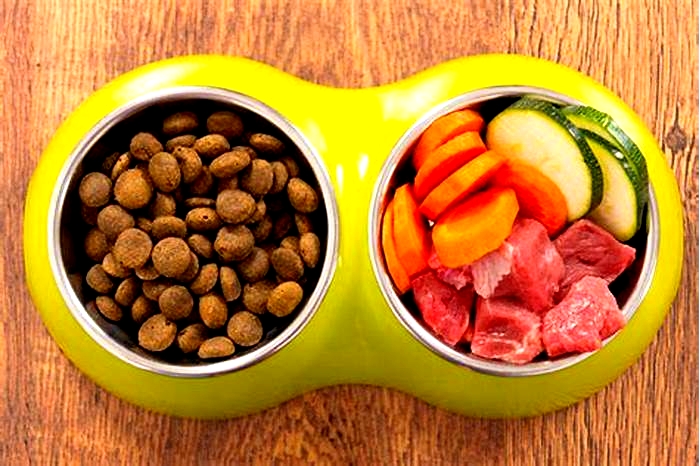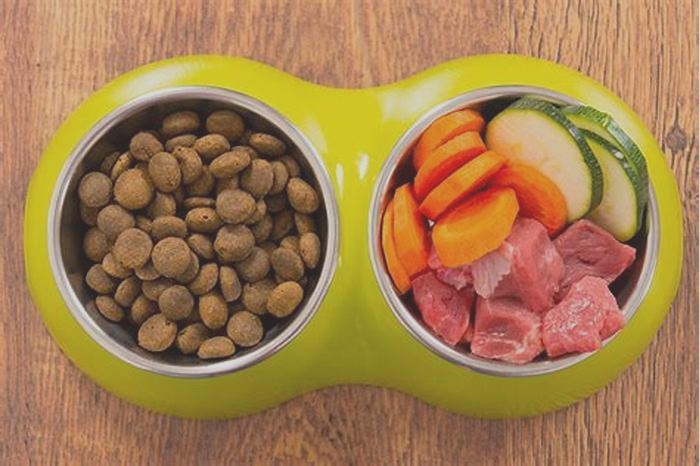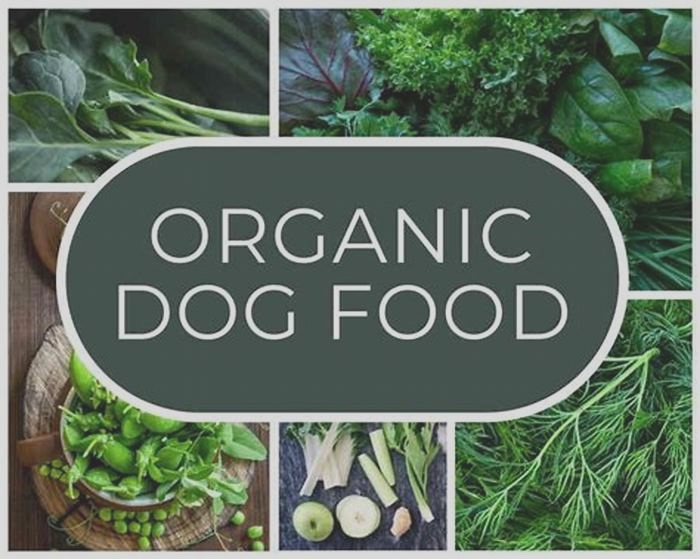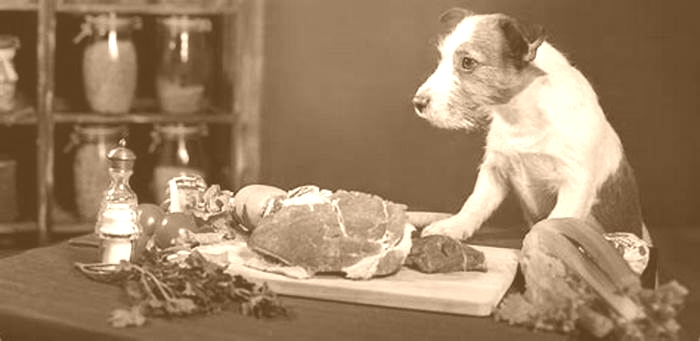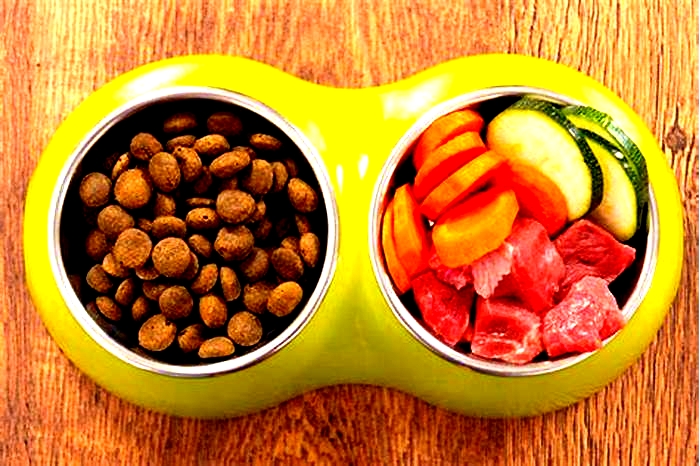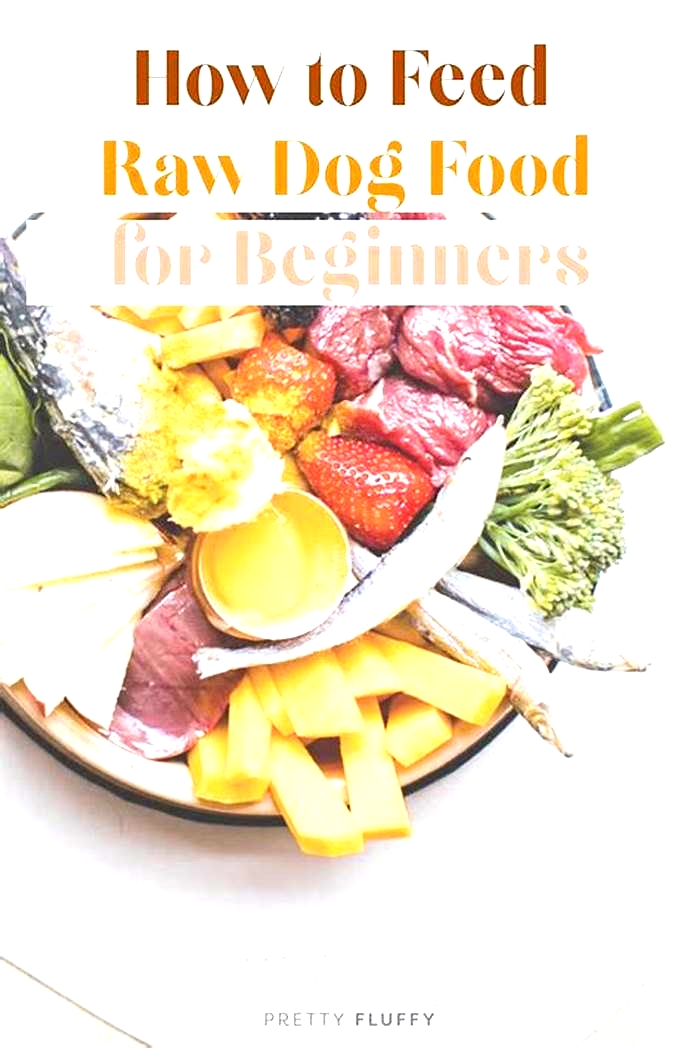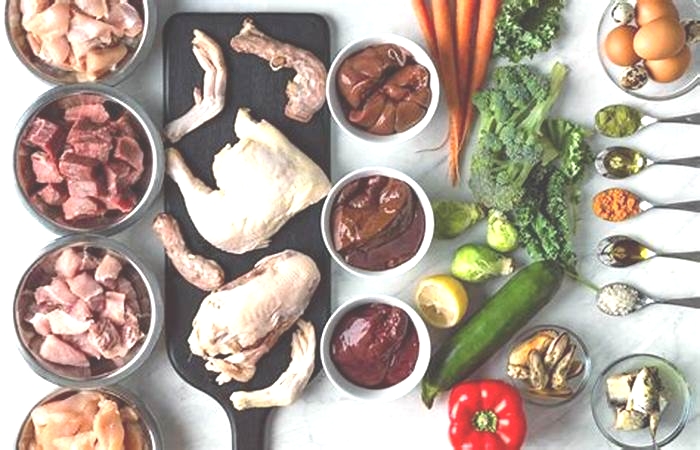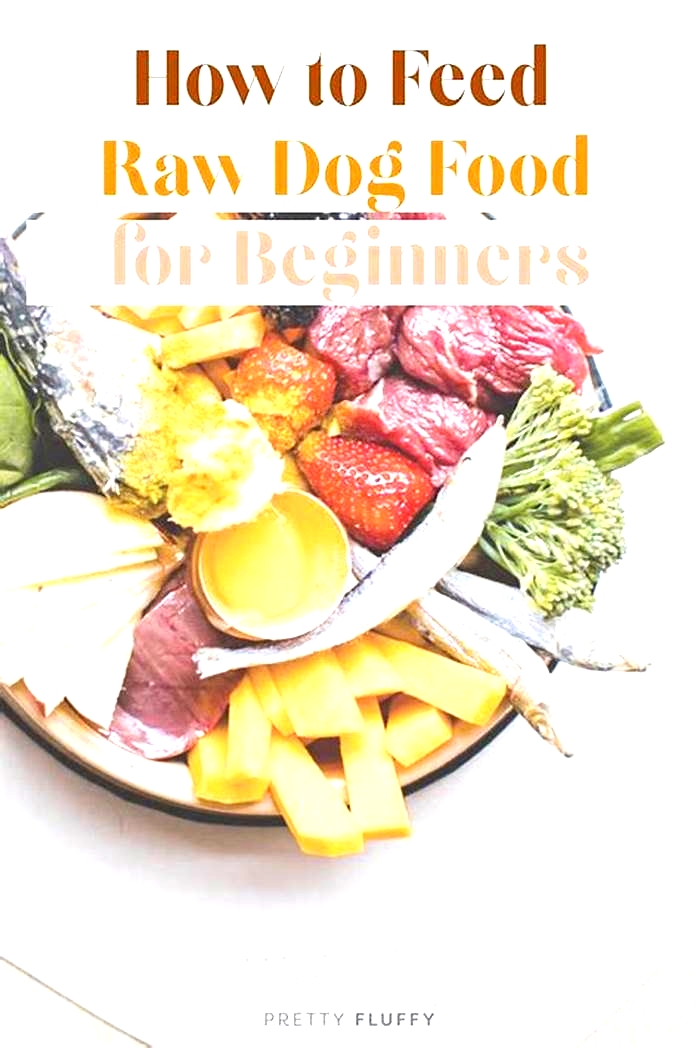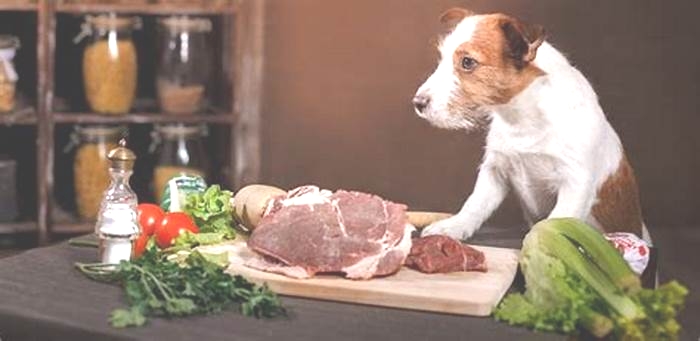From Farm to Fido Exploring the Best Raw Dog Food Options
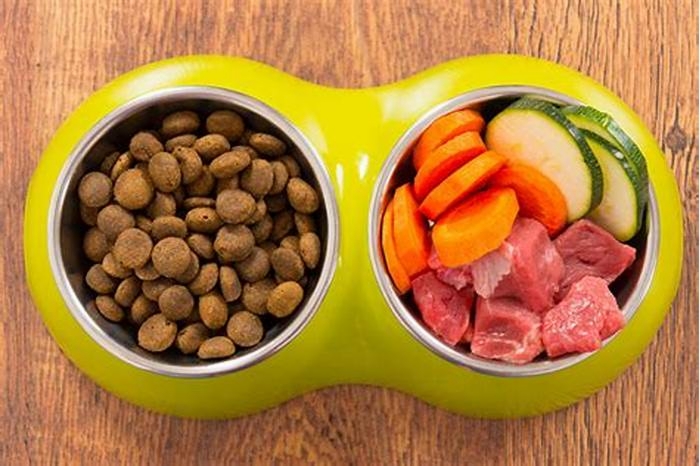
Raw dog food the big questions
Raw dog food diets have been around as long as dogs and their ancestors have been around. Until the creation of dry dog food and canned dog food, dogs lived off raw meat, scraps and anything they could scavenge.
You may have heard of the old English expression as fit as a butchers dog, which implies that a dog living off meat, bones and offal is likely to be in fine fettle.
However, after the creation and growth of mass-market dog food, domestic dogs diets changed and the feeding of raw dog food became less common. That is until recent years
Raw food for dogs has increased in popularity in recent years; some of it homemade, some produced by cottage industries, but increasingly provided by medium to large companies for a national market.
What are the best raw dog foods?
Some work on the prey model, which is an 80% meat, 10% ground bone, 10% organ meat (offal) blend. Others use the recipes akin to the Biologically Appropriate Raw Food (BARF) model, which includes a small percentage of vegetables.
Both kinds profess an authenticity based on dogs evolutionary diets.
It being something new (but also very old) it has generated a lot of doubt, cynicism and questions alongside its popularity.
We put some of the questions we most frequently get asked by readers to Amy Zalneraitis, the CBO at 5-star-rated We Feed Raw.
Is raw dog food safe for dogs?
AZ: Raw dog food is not only safe for dogs, its what is most biologically appropriate for them. Dogs have thrived on a raw, meat-based diet since the dawn of their existence. While weve domesticated dogs and bred them for their appearance, behavior, and temperament, in form and function, their digestive system is identical to their ancestors. With highly acidic stomachs, sharp, pointy teeth, and short, simple digestive tracts, a dogs biology tells us what they should be eating.
So any raw food will do?
Not all raw pet foods are created equal. We use only high-quality, USDA, human-grade meats. We produce our recipes in a USDA-certified facility and all ingredients must comply with rigid incoming quality assurance specifications. Most importantly, to ensure safe raw feeding in the home, we use HPP (high-pressure processing) a non-thermal pasteurization technology that uses extreme cold water pressure (up to 87,000 psi) to ensure our food is free of pathogens such as Listeria, E. coli, and Salmonella.
While not all raw companies in the U.S. do this, we incur the extra cost because it ensures a safe product. Because the process uses pressure rather than heat, there is no change in product taste, texture, or nutritional value.
Is raw dog food safe for humans?
It depends if you mean to eat or handle. While our food is sourced from USDA, human-grade meats, our recipes are not intended for human consumption. Our formulas contain the correct ratio of muscle meat, organ meat, finely ground bone and a high-quality vitamin and mineral mix for full and proper canine nutrition, not full and proper human nutrition.
As for handling, dogs can cope with bacteria in ways that humans cant, but HPP offers extra peace of mind while feeding raw in the home. HPP is used by many reputable raw pet food companies because its a natural way to reduce harmful bacteria while preserving nutrients.
When youre purchasing raw pet food from a reputable company, its easy to feed raw food safely you use the same basic hygiene practices you use when preparing your own raw meats to cook, like washing hands, surfaces, and bowls.
Its more expensive than kibble why should I spend extra?
Because the quality of the food our dogs eat has a direct impact on how well they live. Eighty percent of immune capability is in the gut and low-carb raw diets help to promote healthy gut microflora. Raw food will always be more expensive because quality costs more. Hands down, raw costs more to source and make and its not packed with cheap fillers. While youll pay more upfront with raw, youll save money down the line because youll have a healthier, happier dog and far fewer vet visits.
Why wouldnt I just make raw food at home?
If youre a DIY raw feeder, amazing! Great job! But weve found that many pet parents dont have the time, energy, interest, or resources to make properly balanced raw food at home. Thats where we come in. We plan, portion, package, and deliver. All you have to do is thaw and feed. No concern that your dog is missing important nutrients, no trips to the pet food store, no guesswork.
Do dogs need vegetables?
Our recipes are based on the Prey Model Raw diet: approximately 80% muscle meat (with connective tissue and fat), 10% organ meat (all of which is secreting organ), 10% finely ground raw meaty bones plus a small amount of a high-quality vitamin and mineral mix.
Some of our customers will choose to add veggies to the meals, and thats great, as long as they dont overdo it. If your dog does well with a bit of extra fiber, our Ph.D. nutritionist suggests around a 5-8% veggie inclusion. With dogs, plant matter usually passes out as part of the stool, undigested because their bodies have to work much harder to break it down.
We usually recommend pureeing veggies: dogs do not have natural cellulase, an enzyme that helps to break down fiber, so pureeing them will help aid in digestion.
Do I need to add supplements?
Not with our food. Our food is complete and balanced as is. No need to add supplements. That said, its totally fine to add a small amount of your preferred probiotic, prebiotic, fish oil or omega-3 oil, etc. We just advise that pet parents dont add a multivitamin, as we already include a high-quality vitamin and mineral mix to our recipes.
When it comes to adding other whole foods, like canned pumpkin, phytoplankton, sardines, green-lipped mussels, etc, these can be wonderful, healthy additions and we totally support those as toppers to our meals.
Are there any proven benefits to a raw diet?
A dogs digestive system is identical to its ancestors. They didnt lose the ability to digest their evolutionary diet just because kibble was invented mere seconds ago in geologic time. Therefore, isnt it prudent to imitate what nature provided as a guideline?
As for specific studies, were excited about the work being done at the University of Helsinki on the benefits of a raw dog food diet. Led by veterinary scientist Dr. Anna-Hielm Bjrkman (DVM and PhD), The Dog Risk Study is a university-led, cruelty-free study using 16,000 dogs of all breeds and ages.
The program has already proven that puppies fed raw (vs kibble) have fewer environmental allergies as adults and a reduced risk of developing IBD later in life. Some of the other specific studies its exploring include hip dysplasia, GI issues, chronic ear infections, cancer and tumors.
How do I transition my dog to raw food?
Our intro plan helps to gradually introduce dogs to raw food over a 10-day period. The detailed directions instruct pet parents on how to mix their pups current food with We Feed Raw and increase the percentage of We Feed Raw over the course of 9 days until theyre feeding 100% raw.
What are the best raw dog foods?
Will there be side effects?
While some dogs transition to raw with no issues, other dogs with sensitive stomachs may require a bit more TLC and time. Its all normal. The long-term effects of a healthy, species-appropriate diet make it all worth it: smaller, less smelly stools, shiny skin and coat, cleaner teeth, improved digestion, stronger immune system, better weight control the list goes on.
Can I mix raw food with cooked food?
Yes, absolutely. We encourage pet parents to feed what works for their budget and lifestyle. Adding even 25% raw food to your dogs diet can have life-changing health benefits. Raw feeding isnt an all-or-nothing approach. Using it as a base, mixer, or topper with cooked food or kibble can still have amazing overall health benefits.
Why are some vets anti-raw food?
Were seeing a real shift with conventional vets becoming more raw-friendly. In fact, we work with many conventional vets who not only recommend raw to their clients but feed it to their own pets.
So while the tide is changing, here are some reasons that conventional vets may not be pro-raw: 1) Theyre not taught about raw diets in vet school; 2) Theyve seen homemade raw diets go wrong (imbalanced, missing important nutrients, incorrect ratios); 3) They think its a danger to the humans feeding it. However, serious and reputable raw brands in the U.S., like our company, use HPP to neutralize pathogens for safe feeding in the home.
Is raw dog food human-grade?
Raw dog food is meant to be fed raw and usually contains bone, and therefore cannot technically be labeled human-grade as a whole. So while our food is sourced from high-quality human-grade meats and produced in a USDA-certified facility, we do not make the human-grade claim on our labels.
Are bones and offal actually good for dogs?
Not only are they good for dogs, theyre essential to a complete and balanced raw diet. Organ meats, particularly liver, are packed with vitamins and minerals. Bones are an excellent source of calcium and phosphorus.
Homemade Raw Dog Food: Easy BARF Diet Recipes [Vet Approved]
Canine Bible is reader-supported. We receive affiliate commissions via some of our links. This doesnt affect rankings. Learn more.
This is the most comprehensive guide to the best BARF dog food recipes and learning how to cook them at home. Raw dog food can make our dogs happier and healthier, but you must understand all the components of preparing a complete and balanced raw dog diet at home before getting the apron. A poorly made BARF diet can negatively impact your pup. Today, we share vet-approved raw dog recipes and all the important information about the BARF diet for dogs, including benefits, risks, nutritional guidelines, cooking tips, and everything in between. Our DIY raw dog food guide gives step-by-step instructions for making BARF diet recipes. Lets dive right in!
Table of contents
In This Article:Table of contents
In This Article:Nutrition, Benefits & RisksJump to:Recipes & Cooking
What Is A BARF Diet Recipe?
The raw dog diet, also known as BARF (Biologically Appropriate Raw Food), is designed to mimic a dogs ancestral diet, drawing on the canines carnivorous and primal instincts. All ingredients in BARF diet recipes are uncooked to preserve enzyme content, minerals, vitamins, and other essential nutrients. There are three types of raw dog diets: frozen, freeze-dried, and homemade. The BARF diet reflects what dogs consumed in the wild millions of years ago and typically consists of the following ingredients:
- Raw meat protein
- Bones, either whole or ground
- Organ meats (i.e., livers and kidneys)
- Raweggs
- Dog-safe fresh fruits and vegetables
- Some dairy, such as yogurt.
Can Dogs Eat Raw Meat?
Dogs can thrive on a raw meat diet. Genetic and anatomical research shows dogs have noticeable carnivorous traits that allow them to digest raw meat protein more quickly while killing potential bacteria in decaying meat. Dogs also have a remarkable omnivorous capacity but areoptimized for eating meat. Read our Can dogs eat raw meat? article to learn all the research that supports dog raw meat consumption.
BARF Dog Food Recipe Benefits
Dr. Ian Billinghurst, a veterinarian, pioneer, and top advocate of raw feeding dogs, mentions raw food has several positive effects on canine health, including:
- Shinner coat
- Improved skin health
- More energy
- Lean, strong muscles
- Smaller, firmer stools
- Improved dental health
- Stronger immune system
- Lower risk for allergies
- Improved digestion
- Increased agility
- Bright eyes
- Faster nutrient absorption
- Weight management
Why Feed BARF Homemade Raw Dog Recipes
Increased lifespanThe most extensive study on raw-feeding dogs concluded that a raw diet could add as much as32 months (almost three years) to a dogs life.[1]Dr. Peter Dobias, who has 30 years of veterinary experience and has advocated for raw pet diets since 1995, says, A raw diet will increase a dogs lifespan by 25 percent. Generally, raw-fed dogs are so much healthier. The changes are profound.[2]Balanced without supplementationA study showed its possible to make balanced raw dog food that meets the European Pet Food Industry (FEDIAF and Association of American Feed Control Officials (AAFCO) nutritional guidelineswithout additional synthetic supplementation.[4]Sick dogs got better after switching to a BARF diet632 owners reported that their dogs, suffering from skin-related problems, gastrointestinal issues, eye-related problems, urinary tract issues, and various other diseases, experienced significant recovery from these conditions after switching to a raw dog food diet.[6]Cancer preventionWhen it comes tocancer, raw dog food removes the highly processed food from the equation, which is often linked tocancer issues in dogs. Food processing has been shown to cause free radicals and carcinogenic chemicals to be released. With raw recipes, you no longer have to worry about oxidative stress due to processed food.[9],[10] There is also evidence that raw food decreases the odds of neoplasia development (abnormal growth of cells, cancer) when provided at a young age.[11]Easy digestionHomemade raw dog food is easier to digest than those hard-kibble mystery balls. Feeding your pet freshly made food puts less stress on their digestive system and liver, reducing the likelihood ofbloating or other digestive issues.Deemed healthyA study on feeding practices in the United States and Australia indicated that 98.7% (where 16.2% of 98.7% feed bones or raw food to their dogs) deemed their pet healthy.[3]Health beneficialLisa M. Freeman Freeman, a nutrition professor at the Cummings School of Veterinary Medicine at Tufts University, attributes the benefits of a raw dog food diet, such as ashinier coat,to the high-fat composition of the typical raw diet. Furthermore, For most animals,[raw diets] are more beneficial than processed foods, says Dr. Doug Knueven, DVM, of the Beaver Animal Clinic in Beaver, PA.[5]Fewer allergies and skin problems A study revealed that dogs fed a raw diet during puppyhood showed significantly less allergy and atopy-related skin symptoms in adulthood.[7] Feeding raw bones and cartilageto puppies has been associated with less chronic enteropathy (CE) in later life.[8]Hip dysplasiaBARF diet showed a protective effect against canine hip dysplasia (CHD), and even if only a part of the dogs diet is raw food, it could still help protect puppies from CHD.[12]Avoid unsafe commercial dog foods BARF dog food recipes ensure your dog always eatsfresh, wholesome, and chemical-free foods without additives, fillers, high-glycemic carbs, or colorants commonly found in kibble. Excellent taste, smell & varietyDogs love the taste, smell, texture and variety of fresh ingredients.Homemade Raw Dog FoodRisks
Contamination
Raw ingredients pose a higher risk of contamination with harmful pathogens (i.e., Salmonella, E. coli) that can sicken you and your pet.
Choking
Feeding whole bones to dogs presents a risk of choking, broken teeth, intestinal obstruction, or internal punctures.
Unbalanced
Cooking nutritionally unbalanced raw food recipes can lead to malnutrition, obesity and other health issues.
Raw allergies
Dogs might be allergic to raw ingredients. An at-home dog allergy test can help you pick ingredients that wont trigger allergies.
How to Reduce Raw Dog Food Risks
- Washing. Wash all meats, organs, and other raw ingredients thoroughly.
- Sourcing. Purchase human-grade, ethically sourced raw ingredients from reputable grocery stores or butchers known for high sanitary standards.
- Raw bones. Feed only small or ground bones, avoid large or heavy ones, and never provide cooked bones as they can splinter when chewed. Remove any bones that may splinter, though this may become unnecessary as your dog grows accustomed to eating raw bones.
- Freeze meats for at least 2 to 3 weeks to kill any parasites. Research found that Salmonella is highly sensitive to freezing and showed survival of 1% or less after 48 hours. E. coli proved less sensitive, showing a survival rate ranging from 10% to 30% during the first week of storage. However, after two weeks of storage, most samples declined compared to salmonellae.[13]
You can get personalized nutritional advice from a registered vet nutritionist through Vetster anytime, anywhere. You can also chat with an online vet and ask them questions about your dogs nutritional needs.
How to Make Raw Dog Food Recipes
A BARF diet should consist of 70%uncooked muscle meat, 10%raw edible bone, 10%vegetables and fruit, 5%liver, and 5%other organs. It must also include the six essential nutrients for a dogs proper growth, body function, and health. These nutrients include proteins, carbohydrates, minerals, vitamins, fats, and water. Its also important to consider your pups weight, health conditions, size, and activity level.
Below is a detailed breakdown of each nutrient and its importance.
BARF Raw Diet Nutritional Guidelines to Follow
Proteins
Protein plays a vital role in your dogs diet, providing essential amino acids necessary for bodily processes, including the creation of blood glucose for energy. Protein also helps build and repair muscles and other body tissues. Its needed to make new skin cells, grow hair, hormones and enzymes. The proteins in your dogs diet must have a balanced amino acid profile and are provided in appropriate amounts.
Protein dietary recommendations for raw homemade dog food:
- Adult dog. 18% dry matter protein (45.0g for every 1,000 kcal ME).
- Puppies & Pregnant or Lactating dog. 22.5% dry matter protein (56.3g for every 1,000 kcal ME).
Raw protein sources for homemade raw dog food recipes include:
- Chicken
- Beef
- Turkey
- Lamb
- Salmon
- Pork
- Eggs
Carbohydrates
Dogs need energy for daily activities, growth, pregnancy, lactation, and exercise. This energy, measured in calories, comes from carbohydrates, proteins, and fats. Omnivorous animals, including dogs, derive some energy from carbohydrates. Carbohydrates supply glucose needed by the brain, nervous system, and other critical organs for normal function in dogs. You can use our dogcaloriecalculator to find the exact caloric needs of your dog based on his weight. Ensure you follow the 10% rule if feeding treats to your dog. Food would equal 90% of the total calories and treats the remaining 10%.
Energy dietary recommendations for raw homemade food based on life stage, weight and activity level.
| Type of Dog | 10 lb | 30 lb | 50 lb | 70 lb | 90 lb |
|---|---|---|---|---|---|
| Puppies | 990 | ||||
| Inactive Dog | 674 | 989 | 1,272 | 1,540 | |
| Adult Active Dog | 922 | 1,353 | 1,740 | 2,100 | |
| Pregnant Dog | 1,274 | 1,940 | 2,570 | 3,170 | |
| Young Active Dog | 993 | 1,451 | 1,876 | 2,264 | |
| Senior Active Dog | 745 | 1,093 | 1,407 | 1,700 |
Carbohydrate sources for raw dog food recipes include:
- Oats
- Brown rice
- Quinoa
- Sweet potatoes
- Whole wheat
- Pumpkin
Fats
Fats play a multifaceted role in a dogs diet. They are a dense energy source, provide essential fatty acids for skin and coat health, enable absorption of fat-soluble vitamins, improve food palatability, offer insulation and organ protection, support reproductive health, are critical for nervous system function, and serve as a reserve for energy storage.
Fat dietary recommendations for raw homemade dog food:
- Adult Dog. 5.5% dry matter fat (13.8g for every 1,000 kcal ME).
- Puppies & Pregnant or Lactating Dog. 8.5% dry matter fat (21.3g for every 1,000 kcal ME).
Fat sources for raw dog food recipes include:
- Meats fats
- Fish oils
- Olive
- Egg yolk
- Sunflower oil
- Canola oils
Minerals
Minerals in a dogs diet are indispensable for bone and dental health, nerve function, enzymatic reactions, fluid balance, oxygen transport, and maintaining the bodys pH level, making them essential for overall health and metabolic processes. Proper mineral balance is crucial and should be carefully managed to avoid deficiencies or excesses.
These 12 minerals are known to be essential nutrients for dogs:
- Calcium
- Potassium
- Sodium
- Magnesium
- Iodine
- Chlorine
- Iron
- Copper
- Selenium
- Manganese
- Zinc
- Phosphorus
Mineral sources for homemade raw dog food include:
- Spleen (Iron)
- Raw bones (Calcium)
- Eggshells
- Pancreas and thymus (Selenium and phosphorus)
- Stomach tripe (Zinc)
- Trachea (Glucosamine and chondroitin)
- Reproductive organs (Testicles & uterus)
- Sweet potatoes and pumpkin (Magnesium)
- Nuts and legumes (Copper)
- Bananas and carrots (Potassium)
- Seaweed (Iodine)
- Celery (Manganese)
Vitamins
Vitamins in a dogs diet are integral for maintaining overall health and bodily functions. They support vision, immune health, aid in energy metabolism and nervous system function, provide antioxidant benefits, reduce inflammation, prevent diseases and ailments and more. Dogs require vitamins, but only in small amounts, and excessive doses of certain vitamins, like vitamin D, can harm them.
These 12 vitamins are known to be essential nutrients for dogs:
- Vitamins A, B1, B6, B12, D, E & K
- Riboflavin
- Niacin
- Folic Acid
- Pantothenic Acid
- Choline
Vitamin sources for raw dog recipes include:
- Liver (Vitamins A, D, and B)
- Lungs (Vitamin B)
- Kidney (Vitamins A, D, and E)
- Brain
- Eyeballs
- Heart (Vitamin B12 and niacin)
- Sweet potatoes and spinach (Vitamin A)
- Broccoli (Vitamin C)
- Kale and parsley (Vitamin K)
- Squash (Vitamin E)
- Apples, cranberries, and blueberries
Water
Water is vital in a dogs diet to maintain hydration, support body functions such as digestion, nutrient absorption, and waste excretion, lubricate joints, regulate body temperature, ensure proper organ function, and facilitate metabolic processes. Continuous access to clean water is as crucial as providing nutritious food for overall health and well-being. Generally, dogs should drink 2 to 3 times the amount of their dry food intake daily. However, dogs can naturally regulate their daily water consumption if water is readily available from various sources.
*If feeding the Prey model, this method typically consists of 80% muscle meat, 10% bone, and 10% organs (half of which is liver.). No fruits or veggies.
Source: We compiled the data for the table above by referencing the Association of American Feed Control Officials (AAFCO) guidelines and the Nutrient Requirements of Dogs Report by the National Research Council (NRC). The Food and Drug Administration (FDA) utilizes the information from these reports to regulate and ensure the safety of pet foods.
Homemade BARF Recipe Dog Food Delivery Service
We Feed Raw
Who Its For: The perfect raw dog food recipe if you dont have time to cook for your dog or are unable to balance nutrients to provide a balanced diet.
Are you confused about preparing a balanced dog raw meat diet? Do you have a busy lifestyle with little cooking time for your pup? Dont know where to start? If you answer yes to one or more of these questions, a raw dog food delivery service is the best way to let your dog reap the benefits of eating raw.
We Feed Raw is one of our favorite choices and offers the best BARF diet recipes for dogs available on the market. This company is the pioneer of raw dog food. They deliver Biologically Appropriate Raw Food straight to your door. Their formula is a balanced blend of raw meat, fruits, vegetables, organs, and bones. Plus, its supplemented with four other key ingredients. All of their ingredients are USDA-sourced. Their formulas are developed with the input of aveterinary nutritionistto meet the nutritional guidelines AAFCO sets.
Our readers get 25% offtheir first order with the code CB25. Use Canine Bibles link to get started.
Recipes, Cooking Tips & MoreJump to: Benefits & Nutrition
Homemade Raw Dog Food Recipes Vet Approved
Here are our favorite balanced, vet-approved, and complete homemade raw dog food recipes. Weve also included a special treat recipe for your dog, enriched with the health benefits of our favorite ingredient: dog CBD oil. CBD oil might help with issues like seizures, anxiety, arthritis, inflammation, pain, and overall wellness.
Note:Consult your vet before adjusting your dogs diet. The recipes below dont specify serving sizes since they depend on your dogs breed, weight, age, activity, and health. As a guideline, consider feeding the equivalent amount youd give in kibble, but always consult your veterinarian for proper portioning.
Forest Feast for Fido
Fido Raw Feast
 Canine Bible
Canine BiblePrep Time 20 minutes mins
Cook Time 30 minutes mins
- 2.5 lbs of lean chicken
- 1 lb turkey hearts
- 1/4 lb chicken liver
- 4 pasture-raised eggs without shells
- 8 oz of green beans
- 1/2 oz of finely chopped kale
- 6 oz of mixed berries (blueberries, raspberries and strawberries)
- 2 gr of krill oil powder
Prepare the chicken: Cut the chicken into small, bite-sized pieces appropriate for your dog's size. If you prefer, you can grind the chicken using a meat grinder.
Prepare the organs: Finely chop the turkey hearts and chicken liver, or grind them together with the chicken if your dog prefers or requires a finer texture.
Veggie and berry puree: Puree the green beans, kale, and mixed berries in a food processor until smooth. This helps improve digestibility and nutrient absorption.
Mix together: In a large bowl, combine the ground or chopped chicken, turkey hearts, chicken liver, and eggs. Add the veggie and berry puree along with the krill oil powder. Mix thoroughly to ensure even distribution of all ingredients.
Portion and freeze: Divide the mixture into smaller containers based on your dog's daily food intake. Freeze the portions. You can thaw them in the refrigerator 24 hours before feeding.
Blueberry-Banana CBD-Infused Dog Treats
Treat your dog with these nutritious, therapeutic, and delicious homemade CBD treats. They are made with bananas, a great source ofessential vitamins and minerals(like potassium, vitamin C, and vitamin B6). Banana also aids with digestion and energy. Coconut is added for skin and coat, digestion and helps reduce allergic reactions.
Remember to consult your vet to ensure CBD is safe for your dog and that you are giving the correct dosage. Alternatively, you can buy commercially available CBD dog treatsso your pup can experience CBDs benefits without the cooking.
Ingredients
- 120 mg of the best CBD oil for dogs
- 2 1/2 cups gluten-free flour
- 1/2 cup oats
- 1 ripe banana, mashed
- 1 tbsp honey (optional, for a hint of sweetness)
- 1/2 cup fresh blueberries
- 1/2 cup unsweetened applesauce
- 1 egg, beaten
- 1/3 cup of coconut oil
- 1/2 cup water
- A pinch of sea salt
Directions
- Oven preparation. Preheat oven to 350F and brush a dog biscuit baking tray with coconut oil.
- Banana preparation. Mash a ripe banana until smooth, ensuring no large chunks remain.
- Dry ingredients. Blend gluten-free flour and oats in a medium-sized bowl.
- Wet ingredients. In a separate bowl, whisk an egg until beaten. Add coconut oil, water, mashed banana, unsweetened applesauce, and fresh blueberries. Mix well.
- Combining ingredients. Combine the wet mixture with the dry ingredients, stirring until even. Drizzle in CBD oil, stirring again for even distribution.
- Mold filling. Scoop portions of the mixture with a tablespoon and press firmly into the dog-treat baking mold.
- Baking. Bake in the oven for 30 to 40 minutes until the treats are firm to the touch and slightly golden.
- Cooling and storage. Let the treats cool before transferring them to an airtight container for storage.
Beefy Bark Gourmet Patties
This raw meat food recipe for dogs is among our favorites. Easy to digest and packed with all the essential nutrients dogs need.
Ingredients
- 2 1/2 lbsof ground beef
- 4 ozchicken livers
- 1 carrot, chopped
- 1/2 cup baby spinach
- 1 small apple, cored
- 2 whole eggs (including shell)
- 1/2 cup plain yogurt
- 1 tbspolive oil
- 1 tbspground flaxseed
Directions
- Prepare the veggie and fruit mix: Place the carrot, apple, and spinach in a food processor. Process until the mixture is finely chopped.
- Create the liver blend: Add the chicken livers to the food processor with the veggie and fruit mix. Process until fully mixed.
- Combine with wet ingredients: Transfer the liver and veggie mixture to a large bowl. Add and combine the reaming ingredients, whole eggs (with shells), plain yogurt, ground flaxseed, and olive oil.
- Add the beef: Add the ground beef to the bowl. Use a large spoon to mix everything until the beef is evenly distributed.
- Form the patties: Scoop out portions of the mixture and form them into palm-sized patties. Place the patties on a parchment-lined baking sheet.
- Freeze for storage: Freeze patties and transfer them to a storage container to keep them frozen.
- Serving: The night before you wish to feed, remove the patties from the freezer and place them in the refrigerator to thaw.
Wholesome Turkey and Heart Harmony Blend
If you want to make a simple recipe that can last you well beyond a week, or perhaps you have more than one dog at home, this recipe will make 11 pounds of raw food, which is 6-7 days worth of food for a 50-pound dog, or two smaller dogs.
Ingredients
- 2 pounds of chicken heart
- 1 pound beef liver
- 5 pounds 95% lean ground turkey
- 7 pastured eggs without shells (only 3 yolks)
- 8 ounces of Swiss chard
- 8 ounces (2 stalks) of broccoli
- 8 ounces (4 chopped cups) of dandelion greens
- 12 ounces (2 small clamshell packages) of blueberries or mixed berries (blueberries, raspberries, blackberries, and cranberries)
- 6 tbsps bone meal (seaweed calcium can be used for adult dogs)
- 3 tbsps of ground pumpkin seed powder
- 2 teaspoons sea salt
- 1/4 teaspoon spirulina
Directions
- Prepare the proteins: If you have a grinder, grind the chicken hearts and beef liver together until well combined. If you dont have a grinder, chop the heart and liver into small, bite-sized cubes.
- Egg preparation: Crack 7 eggs, keeping only 3 yolks. You can either whisk them lightly in a bowl or keep them whole to be blended with the vegetables.
- Vegetable and berry puree: Chop the Swiss chard, broccoli, and dandelion greens and place them into the food processor along with the blueberries or mixed berries. Add the eggs (with three yolks), bone meal (or seaweed calcium), pumpkin seed powder, sea salt, and spirulina. Puree the mixture until its smooth and the ingredients are well integrated.
- Mix everything together: In a large mixing bowl, start with the lean ground turkey. Add in the ground or chopped chicken hearts and beef liver. Gradually stir in the veggie and berry puree.
- Serving and storage: Place the mixture into smaller containers and place them in your freezer. Its best to freeze your food in 1-3 day portions.
Hearty Health Organ Patties
This dog homemade raw dog food recipe should be served as a tasty treat or a variety of feed options once or twice a week. Make it with any excess organs. This recipe doesnt include bones and cartilage, so dont use it as a regular meal, but as a raw treat your pet can enjoy now and then.
Ingredients
- 4 ounces of beef hearts
- 4 ounces of kidneys
- 4 ounces of gizzards
- 4 ounces of lamb liver (replacing beef liver)
- 2 tablespoons of precooked leafy greens
- 1 raw egg
Directions
- Prepare the organs: Chop the organs or use a food processor for a more uniform mince.
- Prep the greens: Choose nutrient-rich leafy greens like spinach or kale. Ensure they are precooked, cooled, and finely chopped or processed to enhance digestibility.
- Mix Ingredients: In a large bowl, combine the minced organs and leafy greens. Crack the raw egg into the mixture, including the shells
- Form patties: Form the mixture into palm-sized patties suitable for your dogs size and dietary needs.
- Freezing and serving: Freeze the patties until youre ready to give them to your dog. Thaw the patties in the refrigerator overnight before serving.
Chicken Delight with Garden Greens
This is another easy homemade raw dog food recipe for dogs to add to their menu. It uses raw chicken with a veggie mix. Its full of nutrients and vitamins.
Ingredients
- 2.5 pounds Chicken thighs or breasts
- 1 pound Chicken hearts and liver
- 1/2 pound Ground chicken bone
- 7 lightly boiled chicken eggs (only 3 yolks)
- 8 ounces Organic broccoli (rich in vitamin C, fiber, and other nutrients)
- 8 ounces of organic celery (a good source of dietary fiber and water)
- 8 ounces of organic spinach (high in vitamins and minerals)
- 8 ounces of organic carrots (rich in beta-carotene and fiber)
- 2 tbps of alfalfa meal
Directions
- Prepare the chicken: Chop the chicken thighs or breasts into bite-sized pieces suitable for your dog. Clean the chicken hearts and liver, trim excess fat, and chop into small pieces.
- Egg preparation: Lightly boil the eggs to reduce the risk of bacteria.
- Vegetable prep: Chop the broccoli, celery, spinach, and carrots into small pieces, or use a food processor to puree for easier digestion.
- Mixing: In a large mixing bowl, combine the chicken, organ meats, ground bone, chopped vegetables, and alfalfa meal.
- Storing: You can serve one portion fresh immediately. Store the remaining food in airtight containers or freezer bags and place it in the freezer.
More Raw Food Diet For Dogs Recipes
If you want more raw dog food recipes for your dog, cookbooks can be useful. Our favorite book for raw homemade dog food recipes is A Novices Guide to Raw Feeding for Dogs.
How to Cook Homemade Raw Dog Food (DIY Video)
Watch this video and learn to make your own raw dog food recipes.
Best Homemade Raw Dog Food Recipe Practices
- Understand your dogs nutritional needs
- Do not use inadequate or dangerous recipes
- Ensure your dogs meal is balanced
- Do not use toxic ingredients
- Understand the impact of food and dietary changes
- Do not neglect your dogs health conditions
- Switch to raw gradually
- The diet must be based on your dogs life stage nutritional needs (puppies, adults or seniors)
- Liver and other organs might be slimy. Be cautious and cut into bite-size pieces to avoid choking
- Feed the leanest ground products possible
- Find a broader variety of cheaper organ meats by visiting your local Mexican, Asian, or farmers market. Alternatively, you can have frozen organ meats packed in ice and delivered directly to your door.
How Much Raw Food to Feed Dogs?
Generally, feed your dog about 2% to 4% of his ideal adult weight. Consider his metabolism, activity level, lifestyle, health, and other factors to determine the perfect amount.
Homemade Raw Dog Food Feeding Chart
To calculate your dogs daily raw food intake, multiply his weight by the percentage below that best fits him.
- Weight maintenance: Feed 2% 2.5% of their current weight in pounds daily
- Active dogs (canine athletes, sport dogs, or highly active dogs): Feed 3% 4% of their current weight in pounds daily
- Senior, less active, or overweight dogs (weight loss): Feed 1.5% 2% of their current weight in pounds daily
- Underweight dogs (weight gain): Feed 3% 3.5% % of their current weight in pounds daily
For instance, for a dog that weighs 50 pounds, here is how much raw food you would need to feed him daily.
| Scenarios | Raw Food (lbs) |
|---|---|
| Weight maintenance | 1 to 1.25 lbs |
| Active dogs | 1.5 to 2 lbs |
| Senior, less active, or overweight dogs | 0.75 to 1 lbs |
| Underweight dogs | 1.5 to 1.75 lbs |
Homemade Raw Diet For Puppies
A puppys dietary requirements differ from those of an adult dog. Compared to adult dogs, puppies require higher protein, fat, calcium, and phosphorus levels. Inadequate or excessive amounts of these nutrients can lead to deficiencies, hindered growth, or lifelong health complications.
Feed puppies 15% bone and less than 20% fat to ensure enough nutrients and minerals. Raw food for puppies should also abide by AAFCO guidelines and include the six essential nutrients mentioned earlier.
- 6 weeks to 5 months puppies. 3-6 meals a day
- 6-12month puppies. 2-3 times a day
- Do not skip meals. Skipping meals is not advisable during your puppys growth and development
- Puppy feeding needs are unique. The science isntexact. Fine-tune their diet. If your puppy is getting chunky, cut back a smidge and vice versa.
How Much Raw Food Should Puppies Get?
Puppies need more calories than adult dogs and should eat about5% to 10%of their weight to support their growth.
Puppy Raw Feeding Chart
General raw feeding guidelines for puppies:
- Puppies 2 to 3 months: 8% to 10% of body weight daily
- Puppies 4 to 5 months: 6% to 8% of body weight daily
- Puppies 6 to 8 months: 4% to 6% of body weight daily
- Puppies 9 to 12 months: 3% to 4% of body weight daily
BARF Dog Food Recipes: Cooking, Handling & Serving Tips
Making homemade raw dog food requires meticulous attention to detail at every step and safety handling.
How to Transition Your Dog to A Homemade Raw Dog Diet
Raw feeding your dog for the first time must be done progressively to allow his digestive tract to adjust and prevent stomach issues. Below is a general schedule for transitioning from kibble to a raw diet.
- Week 1:25% new food and 75% old food
- Week 2:50% new food and 50% old food
- Week 3:25% new food and 75% old food
- Week 4:100% new food
Dont change your dogs food abruptly. It can cause anupset stomach, diarrhea, or vomiting. Monitor your dogs health closely. If you notice any adverse reaction to the new diet, you should go back a week in the transition plan and proceed slowly.
What Foods Should Dogs Never Eat?
Below is a list of the most common toxic ingredients dogs need to avoid.
- Chocolate
- Xylitol
- Onions and garlic
- Avocados
- Coffee, tea, and other caffeine
- Grapes and raisins
- Macadamia nuts
- Raw bread dough
- Alcohol
Here is the complete list oftoxic ingredients dogs should never eat. Please print it out and put it on your refrigerator as a reminder.
Raw Food to Never Feed Dogs
Never feed a raw potato to your dog. Potatoescontain solanine, a toxic compound to somedogs, says the AKC. Raw tomatoes also have solanine. Cooking themreduces the levels of solanine, but its better to stay on the safe side by avoiding them. Dont feed salmonor salmonid species of fish. It can contain the Neorickettsia helminthoeca parasite, which causessalmonpoisoning disease. This disease can be fatal. The small brittle bones can choke yourdogor lodge in his stomach or intestines. Boneless fish (especially oily fish) are allowed only once a week. Never give fish with sharp spines and barbs. No wild pork, bear meat, or meats from wild animals are allowed, not even after freezing. Wild meats contain more parasites than farm-raised meats.
Dogs That Shouldnt Eat BARF Diet Recipes
Raw diets are not suited for all dogs. Dogs withkidney or liver problems should avoid eating raw. Raw foods are generally high in protein; excess protein can stress these organs, worsening either condition. Dr. Doug Knueven, a holistic medicine specialist who consults for Natures Variety (Instinct, a raw pet food brand), says that dogs on chemotherapy or immune-suppressing drugs should be restricted from eating raw food. For dogs suffering from pancreatitis or digestive problems, starting with a fresh dog food recipe diet before switching to raw is recommended.
Is Homemade Raw Food Good For Dogs?
Is raw food good for dogs? Watch this video and learn about raw dog food from the experts.
Dog Raw Diet Supplement
A balanced raw diet shouldnt require additional supplementation. However, poorly made raw diets by inexperienced dog parents, a dogs unique dietary needs, or health conditions may require additional supplementation to specific nutrients. Always consult with your vet to create vet-approved raw dog recipes. Adding a multivitamin likeZesty Paws Multivitamin Chewsensures your dog gets the recommended balance of vitamins and minerals. Making balanced raw dog food recipes can be a tedious process. For more advice on BARF diet nutrition and benefits, check outGive Your Dog a Boneby Ian Billinghurst. This book is considered the Bible of healthy raw dog nutrition.
Monitor Weight And Health
A dogs weight and gut health are essential indicators of their health, and you need to track them when switching to a new diet (i.e., BARF diet). If your dogs weight increases or decreases rapidly, it might be due to food-related health issues. A healthy gut can confirm a smooth transition to your dogs new diet, among other health issues. However, identifying a healthy gut is not an easy task. Fortunately, an at-home dog gut health test can provide insight into your dogs gut health.
Skin or coat issues, excessive tiredness, allergies, weight loss, malnutrition, and obesity can be caused by unbalanced and insufficient meal plans. If you detect any of these symptoms while feeding your dog meals, stop doing it immediately and seek expert advice.
BARF Diet Recipes For Dogs Conclusion & Alternatives
Making raw dog food is fun but should be done diligently under professional guidance. It can be daunting at first, but eventually, it becomes second nature, and the benefits are worth it. Now that you know what you want to make, its time to assemble a shopping list and start with homemade raw. Have fun! Remember, you can always have already made raw dog food delivered to your dog if you dont feel like cooking.
Dont want to feed raw today? Another diet thats proven beneficial for dogs with meat allergies, digestive issues, or food-related health issues isvegan dog food. Its worth checking out.
Like It? Subscribe & Share!
Sources
Canine Bible uses only high-quality sources, including peer-reviewed studies, to support the facts within our articles. Read oureditorial processand product review methodology to learn more about how we fact-check, test products, and keep our content accurate, reliable, and trustworthy.
- Lippert, G., & Sapy, P. (n.d.). Analysis of the longevity of dogs. UKRMB.
- Darwins Natural Pet Products. (n.d.). BARF Diet: Raw Pet Food Diets. Darwins Pet.
- American Veterinary Medical Association. (2008). Raw or undercooked animal-source protein in cat and dog diets. Journal of the American Veterinary Medical Association, 232(5), 687-697.
- Honeys Real Dog Food. (2020). The Raw Proof Report. Honeys Real Dog Food.
- WebMD. (n.d.). Raw Dog Food: Dietary Concerns, Benefits, and Risks. WebMD.
- University of Helsinki. (n.d.). BARF poster. DogRisk.
- University of Helsinki. (n.d.). Puppys diet seems to be a significant factor in the development of allergy and atopy-related skin symptoms. University of Helsinki.
- The effect of puppyhood and adolescent diet on the incidence of chronic enteropathy in dogs later in life. (n.d.). Scientific Reports.
- Podolsky, A. (2019, November 28). Feed the dog not the cancer: The danger of processed dog food. Lyka.
- Harvard Health Publishing. (2018, May). Eating highly processed foods may raise cancer risk. Harvard Health; Harvard Health.
- University of Helsinki. (n.d.). Diet and neoplasia in dogs. DogRisk.
- Hielm-Bjrkman, A. (n.d.). Thesis on dog diet and health. Helda.
- DiGirolamo, R., Liston, J., & Matches, J. (1970). The Effects of Freezing on the Survival of Salmonella and E. coli in Pacific Oysters. Journal of Food Science, 35(1), 13-16.
Canine Bible authorship represents the unified voice of our entire editorial team and our in-house veterinarians rather than a single author. Each article, blog post, and review published under the Canine Bible name undergoes a rigorous review process, involving all team members to guarantee accuracy and up-to-date in accordance with the latest veterinarian research. This collaborative effort is an integral part of our editorial process and aligns with our four pillars of content creation. This approach ensures our content is backed by expert knowledge and factual information, offering our readers reliable, actionable, and trustworthy content.

